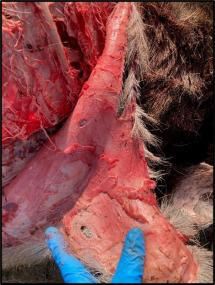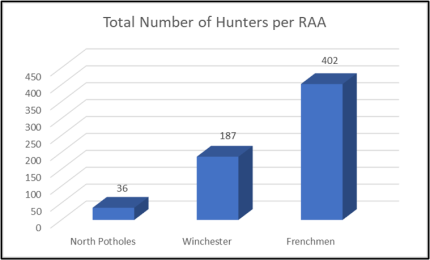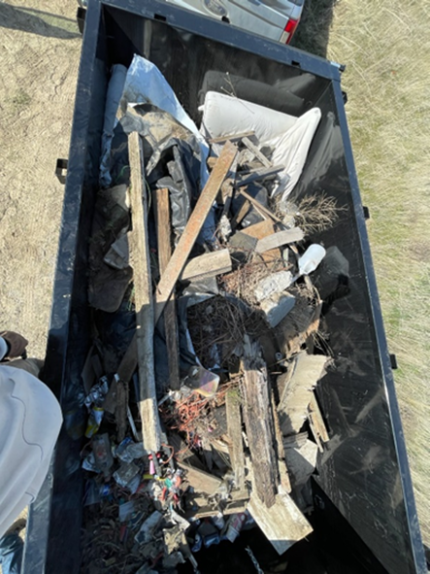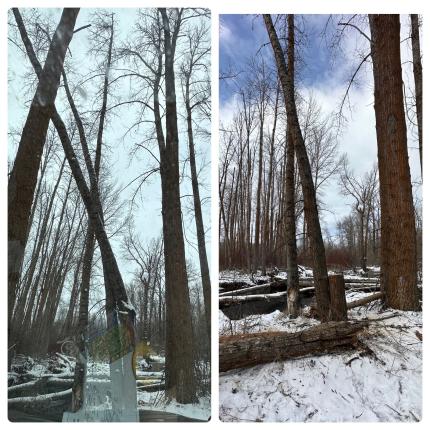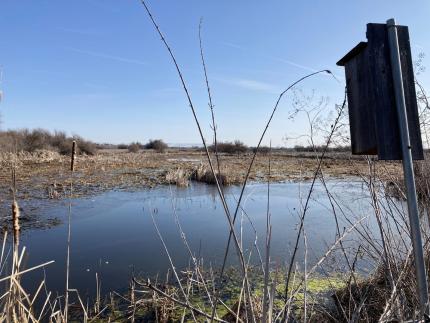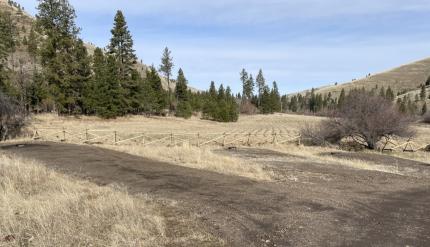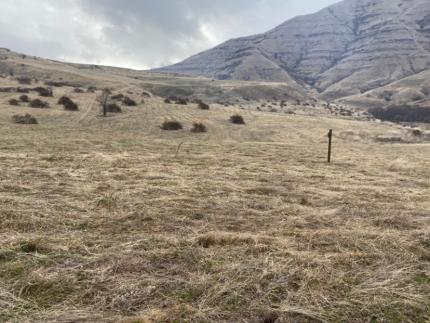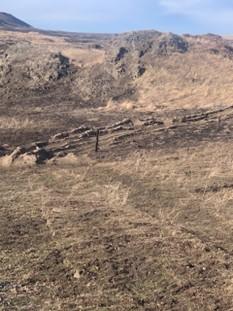Biweekly report Mar1-15 2025 - Region 1 (Eastern)
Managing Wildlife Populations
Deer: Private Lands Biologist Heitstuman followed up on a sick deer report in the Clarkston area with Conflict Specialist Wade. This is a repeat caller. The deer is still mobile and has been for several months.
Bald Eagle: Wildlife Area Manager Dingman got a report of a potentially sick bald eagle from a landowner on the Tucannon River. When she arrived to look at the eagle, it jumped off the fence and flew away downstream. The eagle did not appear to be sick, and the landowner will call back if things change.
Raven/Raptor Survey: Biologist Brinkman conducted a point-count survey to document ravens and raptors observed at each of the 17 roadside point counts in Lincoln County. These weekly surveys are conducted during the sharp-tailed grouse breeding season to provide an index of predator abundance within sharp-tailed grouse breeding habitat.
Forest Grouse Wing Bee: Biologists Lowe and Brinkman hosted the Eastside Wing Bee in District 2 for forest grouse wings collected during hunting season within the eastern Districts. Biologists from the other eastern districts brought wings collected from their respective areas to be identified and recorded. Small game section lead Garrison provided a demonstration on what to look for to identify species, sex, and age from the submitted wings and/or tails. The biologists then broke out into two groups to go through each sample to record those data.
LeClerc Creek Wildlife Area Elk: Acting Wildlife Area Manager Palmer and Natural Resource Technician Graves visited the LeClerc Creek Wildlife Area to familiarize Graves with more of that property. While checking site conditions for work planning needs on the West Branch parcel of the wildlife area, 20 white-tailed deer and 40 elk were observed bedded and feeding on the site. It’s great to see this utilization response to improved wildlife habitat resulting from ongoing forest restoration work on the site.
Providing Recreation Opportunities
Voluntary Public Access Contracts: Private Lands Biologist Thorne Hadley worked with Natural Resource Technician Moberg in sending out A-19 forms to landowners/managers to attain signatures to process payments for access while participating in the Voluntary Public Access Program. Private Lands Biologist Thorne Hadley scanned and uploaded signed A-19 forms for review and payment.
Water Access Site Field Work: Natural Resource Technician Brant serviced water access areas in District 1, performing routine maintenance duties to have sites ready ahead of the fishing season opener in late April. Brant has been focusing on pressure washing the restrooms and taking advantage of the seasonal lack of foliage on shrubs to get into the bushes for a deep clean of litter.
WT Wooten Wildlife Area Lakes: Natural Resource Technicians Jensen and Tritt checked the lakes daily and adjusted as necessary. The technicians picked up trash around the lakes. The technicians used tailings that were delivered to the Wooten Headquarters to make repairs to the road between Rainbow Lake and the Deer Lake inlet where there are large potholes from the Rainbow Lake construction project.
Region 1 South Access Areas: Access Manager Heimgartner serviced access sites at the Wooten Wildlife Area, upper and lower Grande Ronde, and Heller Bar. At Heller Bar, Heimgartner and Wildlife Area Manager Dice filled a troublesome pothole with sealant material Greg picked up from a vendor in Spokane.
Providing Conflict Prevention and Education
Turkey: Natural Resource Technician Edmondson responded to several calls about turkeys causing damage. Edmondson assisted Springdale residents to help them deter turkeys from their property.
Elk: Private Lands Biologist Heitstuman conducted an elk search on private lands in the Cloverland area per the request and reports from landowners concerning crop damage. The details were added to the sighting map developed by Heitstuman on Google Earth. Heitstuman conducted an onsite review of a property enrolled in the Hunt by Written Permission program for suitability to enhance wildlife habitat.
Sick moose reported: Wildlife Conflict Specialist Harris received multiple reports of sick moose in the Spokane area. The moose were reported as being skinny and missing large patches of hair. Harris advised callers that the hair loss was caused by winter ticks.
Conserving Natural Landscapes
4-O Ranch Wildlife Area: Wildlife Area Manager Dice looked at property lines on the north side of the wildlife area to assess whether or not Capital and Asset Management Program staff members could enter and successfully walk planned fence lines. The property line was still a little wet for hiking, with snow still covering some of the lines. The other concern is how to cross Wenatchee Creek, given how high it is with snowmelt. Dice put up many new signs in an effort to control access from e-bikes and notify people that either a Discover Pass or Vehicle Access Permit is required to recreate on the wildlife area.
Revere Wildlife Area On-Site Meeting: This week Wildlife Area Assistant Manager Wagner and Natural Resource Technician Duclos went to the Revere Wildlife Area to meet with the new agriculture lease, Melville, and check a key out to him. Currently, the new lease is in the process of being finalized and sent out for signature. While at Revere, Wagner and Duclos meet with Wildlife Biologist Jennings to go over what area of the fences and what wire needs to be removed to make it “wildlife friendly.” The plan is to exchange the top barbed wire with a smooth wire on the north and westside of the property to meet that standard. The bottom wire is already smooth wire. Wagner and Duclos came across a herd of elk at Revere.
Bureau of Land Management (BLM) Property Native Grassland Field Inspection: This week Wildlife Area Assistant Manager Wagner made a trip over to the BLM native grassland field that was planted last November to inspect for erosion due to all the rain and the melting snow. Wagner took photos of the erosion that will have to be repaired this spring to prevent further erosion. Wagner and Natural Resource Technician Duclos will fill in the ditches this coming spring and plant the disturbance with Great Basin Wildrye to provide cover and establish a root mass to prevent further erosion.
Ducks Unlimited Tour of Revere Wetland Project: This week Ducks Unlimited employees made it down to the Revere Wildlife Area to check out the successful wetland project. Prior to this wetland being excavated and cleaned out, Bulrush has covered the entire area which left no open water.
Providing Education and Outreach
Deer Park Elk Meeting: Wildlife and enforcement program staff members from Districts 1 and 2 gave a presentation to landowners and producers around Deer Park regarding elk population management and Damage Prevention Cooperative Agreements. Staff members also discussed options for managing the growing elk herd, which resides primarily on private cropland.
Public calls and emails: Biologists Lowe and Brinkman responded to members of the public on a variety of topics, including raising game birds, outreach programs, scat identification, and avian influenza.
Kindergarten Class: Biologist Brinkman talked to a kindergarten class about what it’s like to be a biologist. He was joined by a wildlife biologist from U.S. Fish and Wildlife Service to talk to the class. Biologist Brinkman provided a wide variety of animal skins, skulls, scat, and tracks for the kids to handle, and they were encouraged to ask questions about the different animals.
Science and Leadership Meeting: Wildlife Area Manager Dingman participated in the Science and Leadership meeting and field tour with Washington Department of Fish and Wildlife (WDFW), tribal governments, PA 5-15 consultants, Salmon Recovery Board, U.S. Fish and Wildlife Service, Department of Ecology, Lower Snake Comp, and various other folks. WDFW presented the preferred alternative that was agreed upon with the agency to provide a starting point for the comanagers to come together in agreement on a path forward for the Tucannon floodplain on the WT Wooten Wildlife Area.
Reardan High School Debate Class: This week the Reardan High School debate team came out to the Swanson Lakes Wildlife Area office to perform in front of staff members. The debate topics this year range from grazing on public lands to riparian setbacks. Eleven students came out to debate these topics in front of Wildlife Area Manager Finch, Wildlife Area Assistant Manager Wagner, and a local rancher Schneider. After the debate, the panel asked several questions to test the student’s knowledge on each topic. The students did an excellent job answering the questions to stand behind their stance on the topics.
Conducting Business Operations and Policy
Public Assistance: Wildlife Area Manager Dice accompanied Enforcement Sergeant Mosman on a welfare check on a woman at the Wenatchee Guard Station in the Umatilla National Forest Thursday evening. They rode Enforcement’s snowmobiles from the Cloverland Snowpark to the Guard Station. The woman was overdue to get back to her vehicle and her family was concerned. She was found safe and sound, and said she had a miscommunication with her family.
Other
University Student Meeting: Supervisor Earl met with a student from the University of Idaho who is interested in seasonal employment. Earl passed along several summer opportunities that may be coming available soon in the area.






















































